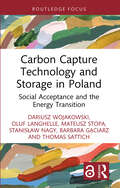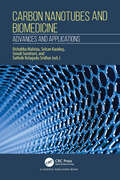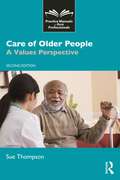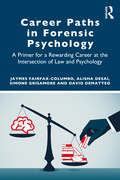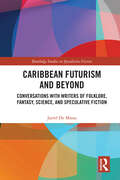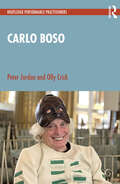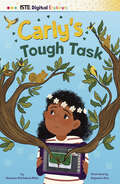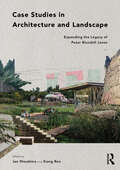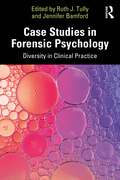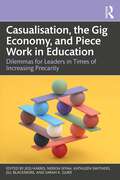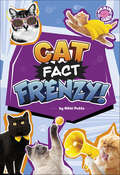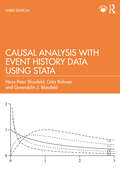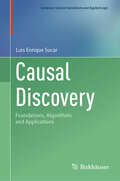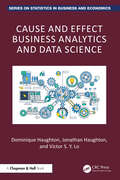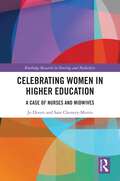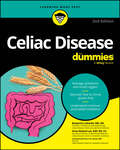- Table View
- List View
Carbon Capture Technology and Storage in Poland: Social Acceptance and the Energy Transition (Routledge Focus on Energy Studies)
by Oluf Langhelle Dariusz Wojakowski Mateusz Stopa Stanisław Nagy Barbara Gąciarz Thomas Michael SattichThe book describes the results of the AGaStor Project’s social research carried out in northwestern Poland which recognizes the main social opportunities and barriers to the introduction of CCUS to society.At the national and regional level, the social barriers of CCUS acceptance are ignorance, uncertainty and the lack of public debate about this technology. On the local scale, social acceptance depends on the needs and fears of the local community. Some of those fears – distrust and perception of CO2 as a waste – could be recognized as universal dilemmas connected with CCUS. Although as knowledge about CCUS increases, a significant change in attitude can be observed. This change does not mean an acceptance of that technology. It is rather a shift towards more benign forms of resistance – from NIMBY to WIMBY. The book presents actual mechanisms of social reaction to UGS and CCUS investment, which will be a valuable contribution to managing social change in the context of green transition.The issue of social acceptance of CCUS should be of interest to decision makers and practitioners who manage investment projects in the broadly understood green transformation on a daily basis, and also to postgraduate students, researchers, academics and lecturers in political studies, sociology or economics, and in engineering studies connected with energy transformation.
Carbon Nanotubes Mediated Bioactive Delivery
by N. K. Jain Neelesh Kumar MehraCarbon nanotubes (CNTs) have emerged as novel carbon-based nanomaterials with unique physicochemical properties for pharmaceutical and biomedical applications. This book provides the fundamental concept, basic physicochemical properties, functionalization, method of synthesis, applications, and regulatory considerations of CNTs. The primary objective of the editors and authors is to exhaustively cover the fundamentals of carbon nanomaterials, carbon nanotubes, functionalization and chemistries involved, drug delivery aspects, and applications along with their regulatory aspects.
Carbon Nanotubes and Biomedicine: Advances and Applications
by Sathvik Belagodu Sridhar Malviya Rishabha Karakuş Selcan Sundram SonaliThis book explores the advanced integration of nanotechnology and biomedicine, providing an in-depth analysis of the transformative impact of carbon nanotubes (CNTs) on healthcare. It provides a comprehensive coverage of the distinctive characteristics of CNTs, including their remarkable mechanical strength, electrical conductivity, and large surface area, which make them very suitable for numerous biomedical uses. The book provides an overview of the process of synthesizing and functionalizing CNTs. It then delves into the specific applications of CNTs in drug delivery systems to improve the effectiveness and targeting of therapeutic agents. Additionally, the book explores the use of CNTs in imaging and diagnostics, enhancing techniques such as MRI and fluorescence imaging. The book also discusses the involvement of CNTs in tissue engineering, namely in the fabrication of scaffolds that facilitate cell growth and tissue regeneration. It explores the application of CNTs in biosensors, where their high sensitivity enables early and accurate identification of diseases. Antibacterial characteristics of CNTs are reviewed in order to hinder infections in medical devices and implants. The potential of CNTs in gene therapy to enhance genetic treatments is also explored in the book. It addresses the concerns related to the toxicity, biocompatibility, and regulatory issues of CNTs. It carefully balances the promising potential of CNTs with the practical implications of their usage in the field of biomedicine. This book is indispensable for researchers, doctors, and individuals with an interest in the cutting-edge utilisation of nanotechnology in the field of medicine.
Care of Older People: A Values Perspective (Practice Manuals for Busy Professionals)
by Sue ThompsonThis text provides a foundation of essential knowledge and practical guidance for building best practice in the care of older people.Fully updated for its second edition, Care of Older People uses a whole-person and values-led approach to explore practice with older people, providing the opportunity for practitioners to reflect critically on not just what they do but also on how and why. It includes two new chapters, the first looking at the ways in which digital technologies can impact on how care support is delivered and the potential for older people’s lives to be enriched or otherwise by them, and the second reflecting the particular challenges of helping older people at the end of their lives to manage their needs. Highlighting how older people in receipt of care support can be enabled to be co-producers of knowledge, it challenges the depiction of older people with support needs as one-dimensional individuals rather than multi-dimensional people with life left to live.This accessible book is an invaluable learning resource for all those working, or studying, across the caring professions, including social work, social care, nursing, occupational therapy and anyone committed to excellence in eldercare.
Career Paths in Forensic Psychology: A Primer for a Rewarding Career at the Intersection of Law and Psychology
by David DeMatteo Jaymes Fairfax-Columbo Alisha Desai Simone GrisamoreCareer Paths in Forensic Psychology offers a comprehensive introduction and guide to the varied career paths for aspiring forensic psychologists, showing what a rewarding career at the intersection of law and psychology can look like in practice.The book is divided into five parts. Part I provides an overview of the field of forensic psychology and also briefly explores its origins and evolution in the United States. Additionally, it explores common professional activities of forensic psychologists, as well as common career settings in which they ply their trade (academic settings, clinical settings, policy settings). Part II examines employment in academic settings, chiefly research academia, practice-oriented academia, and teaching-focused academia. Part III discusses opportunities for clinical-forensic psychology practice, in both the public sector and in private practice settings. Part IV considers career opportunities for policy-interested forensic psychologists, including in government agencies and policy-focused non-profit organizations. Finally, Part V gives readers tips on how to pick the best career “home base” for themselves, considers supplemental opportunities that forensic psychologists can pursue if their “home base” does not scratch all their professional itches, and provides guidance on how to put one’s best foot forward as a forensic psychologist and be a worthy representative of the field.This book is an ideal resource for students of forensic psychology and early-career forensic psychologists looking to start and progress their career in academic, clinical, and policy settings, as well as practicing psychologists looking to navigate career changes and transitions.
Caribbean Futurism and Beyond: Conversations with Writers of Folklore, Fantasy, Science, and Speculative Fiction (Routledge Studies in Speculative Fiction)
by Jarrel De MatasCaribbean Futurism and Beyond is a tripartite combination of interviews with writers of the sf (speculative fiction, science fiction, fantasy, and folklore) genre, literary and cultural analysis of those interviews within the context of seven discrete yet overlapping dimensions – folklore, mythology, children’s and young adult literature, science, technology, climate disaster, and identity; and a theoretical basis of Caribbean futurism as an esthetic practice reflecting not just future but also past and present experiences of Caribbean people. The combination of interviews, analysis, and theory contributes to the ongoing questions that have been and will likely remain central to being and belonging to the Caribbean. The authors share their creative processes, inspirations, and the unique ways they address Caribbean experiences through stories that expand the boundaries of the genre.
Carlo Boso (Routledge Performance Practitioners)
by Peter Jordan Olly CrickCarlo Boso is one of the foremost exponents of Commedia dell’Arte in the contemporary performance world, having trained generations of young actors in its history, techniques and performance. Staying true to – and promoting renewed awareness of – the diverse cultural and linguistic backgrounds of most commedia troupes, his work has also done a great deal to democratize this central pillar of European theatre, placing the actor and the audience squarely at the centre of his craft.This book includes the following:• A biographical account of Boso’s route into commedia, his foundational work and the significance of his practice to contemporary performance.• An extended interview that allows Boso to set out in his own words the key elements of his work and his vision of an articulate, politically and socially engaged actor.• A detailed analysis of his production of La Pazzia di Isabella with TAG Teatro, providing an object lesson in how to make a centuries-old scenario suitable for touring 250 performances across nine countries.• A developmental series of exercises for approaching improvisation material, as well as mask work, composition, music and acrobatics.As a first step towards critical understanding, and as an initial exploration before going on to further, primary research, Routledge Performance Practitioners offer unbeatable value for today’s student.
Carly's Tough Task
by Shannon McClintock MillerThe school assembly is just days away, and Carly has been chosen to present her class’s findings from a nature hike. With so many photos, notes, and sketches, Carly feels overwhelmed. Created in partnership with International Society for Technology in Education (ISTE), this early chapter book weaves in important concepts in technology, like being a creative communicator, seamlessly. And it does so while solving Carly’s dilemma in a relatable and fun way.
Carrion Ecology, Evolution, and Their Applications
by M. Eric Benbow, Jeffery K. Tomberlin, and Aaron M. TaroneThe first edition of Carrion Ecology, Evolution, and Their Applications brought together multiple scientific disciplines to shed light on the importance of carrion within the context of ecology and evolutionary biology, and through applications ranging from human mass disasters to habitat/ecosystem conservation. This second edition builds upon this foundation to include a huge amount of new research, consisting of 33 chapters—9 brand new and the remaining 24 substantially updated and expanded. One of the most significant changes for this edition is the coverage of aquatic ecosystems, both freshwater and marine.The book is now represented by 73 authors from eight countries, incorporating more diverse perspectives and engagement into this multidisciplinary and expanding science. The resulting new edition showcases a broader scope of topics, geographic areas, ecosystems and history of carrion ecology, evolution, and their applications for humanity. It provides the most comprehensive resource on carrion from all ecosystems of the world.The student, academic, and professional will find this book insightful, providing new insights for the fields of molecular ecology, microbiology, entomology, population biology, community and ecosystem ecology, as well as applications in forensics and human and environmental health.
Case Studies in Architecture and Landscape: Expanding the Legacy of Peter Blundell Jones
by Jan Woudstra Xiang RenThe architect, historian and critic Peter Blundell Jones (1949–2016) considered architecture as an expansive field within the arts and humanities and social sciences that included landscape and urban studies. His focus within this built environment was firmly on people and place, which to him meant developing a comprehension of the broad human, material and social engagements with specific localities.His favourite way to explore this human and environmental focus was through case studies of individual places, leading to a modus operandi to tackle the study of any place in a generous, rigorous and comprehensive manner that used the skills of related professions, of the sciences as well as of psychology and anthropology. Being able to adopt such interdisciplinarity determined the real value of his output, which was further enriched through the thick interpretation of placemaking in non-Western cultures.This book, celebrating the East-West Studies in Architecture and Landscape at the University of Sheffield co-founded by Peter Blundell Jones in 1995, presents 16 distinctive case studies in order to underline the relevance of his case study methodology and global legacy. It is intended to have relevance for a range of disciplines including the design ones of architecture, landscape and urban design and planning, as well as anthropology, history, geography and cultural studies.
Case Studies in Forensic Psychology: Diversity in Clinical Practice
by Jennifer Bamford J. Tully RuthThis book shines light on the often-hidden work completed by psychologists in forensic settings. It follows on from Case Studies in Forensic Psychology (2019) and Further Case Studies in Forensic Psychology (2022).The case studies presented involve service users with varied presentations such as acquired brain injury and ADHD, as well as a variety of offending histories including sexual, terrorism-related, and violent offences. Chapters present the individual’s background, assessment or treatment completed with them, and discussion of the features of the case in the context of relevant literature. Some chapters detail informative and evidence-based discussion of the authors’ experiences working with particular groups including recommendations for others working in that field (e.g. assessment of clergy, so called ‘honour-based violence’, assessment of those with terrorism-related convictions). One chapter is co-produced with an expert by experience. The book demonstrates to readers the complex and individually responsive psychological work engaged in by clinicians and underscores the importance of considering diversity and individual presentation within this work. It brings together clinical practice in the context of models of treatment and research, to demonstrate application at an individual level.Case studies in Forensic Psychology: Diversity in Clinical Practice is key reading for psychologists, allied health professionals, and practitioners at any career stage. Students will also find this book useful, as will those interested in real-world clinical practice of psychologists in forensic contexts.
Casualisation, the Gig Economy, and Piece Work in Education: Dilemmas for Leaders in Times of Increasing Precarity
by Jess Harris Jill Blackmore Nerida Spina Kathleen Smithers Sarah K. GurrThis book examines a range of ethical complexities associated with precarious work across educational sectors internationally.Our aim is to examine the experiences of the increasing reliance on casual and temporary employment in education settings for all educators. This volume brings together academic chapters, focused on the affective, ethical, and practical challenges faced by all educators working in highly casualised contexts, while working to provide quality education for all students. These chapters are complemented by reflections from a variety of educators and educational leaders who have navigated ethical dilemmas related to precarious employment across sectors from early childhood to higher education.When viewed together, the chapters and reflections highlight the impacts of neoliberal market-driven policies on the education sector and work to present a series of possible ‘pathways forward’ for education workers navigating this precarious terrain.
Cat Fact Frenzy!
by Nikki PottsBrace yourself for a CAT FACT FRENZY! Did you know that some cats can reach speeds of 35 miles per hour? Or that cats can make more than 100 sounds? Dozens of bite-size cat facts are paired with fun feline photos, welcoming in even the most reluctant readers. Whether kids are in the mood to browse or to devour a book from cover to cover, even a dedicated cat fan is sure to learn something surprising as they flip through these pages.
Cat Fact Frenzy! (Fact Frenzy)
by Nikki PottsBrace yourself for a CAT FACT FRENZY! Did you know that some cats can reach speeds of 35 miles per hour? Or that cats can make more than 100 sounds? Dozens of bite-size cat facts are paired with fun feline photos, welcoming in even the most reluctant readers. Whether kids are in the mood to browse or to devour a book from cover to cover, even a dedicated cat fan is sure to learn something surprising as they flip through these pages.
Cat Fact Frenzy! (Fact Frenzy)
by Nikki PottsBrace yourself for a CAT FACT FRENZY! Did you know that some cats can reach speeds of 35 miles per hour? Or that cats can make more than 100 sounds? Dozens of bite-size cat facts are paired with fun feline photos, welcoming in even the most reluctant readers. Whether kids are in the mood to browse or to devour a book from cover to cover, even a dedicated cat fan is sure to learn something surprising as they flip through these pages.
Catatonia: A Practical Guide to a Clinical and Scientific Conundrum
by Georg Northoff Dusan HirjakCatatonia is a complex neuropsychiatric disorder characterized by motor, affective and cognitive-behavioral symptoms, presenting significant challenges for both psychiatrists and neurologists. It occurs in 5–18% of patients in inpatient psychiatric units and in 3.3% of those in neurology or neuropsychiatric tertiary care inpatient settings. Despite its relatively high prevalence, catatonia is often underdiagnosed and inadequately treated, which can lead to substantial disadvantages for patients and may be associated with potentially life-threatening conditions. This comprehensive guide is designed to assist clinicians, researchers, and students in understanding and treating catatonia. It navigates through the history of the condition, exploring its phenomenology, clinical manifestations and pathophysiology, before delving into effective treatment strategies. By providing a clear and thorough overview, this guide simplifies the recognition of catatonia and promotes prompt and accurate treatment, encouraging future research endeavours in catatonia.
Catfishes, a Highly Diversified Group: Volume 2: Evolution and Phylogeny
by Roberto E. Reis Gloria ArratiaThe order of Catfishes (Siluriformes) is one of the largest in number of families, genera, and species. The group is found in most freshwaters and shallow saltwater bodies around the world. Its extraordinary evolutionary and biogeographic pathways leave many open questions on its origin and large diversification that make its study a complex subject, yet a fascinating field for research. Catfishes, a Highly Diversified Group is divided in two volumes. Volume 1 (Their Outstanding Biology; 14 chapters) aims to rectify the incomplete information on the enormous morphological diversity of the group, special habits and adaptations to specific environments, and morpho-functional characteristics of the catfishes. Volume 2 (Evolution and Phylogeny; 18 chapters) deals with evolutionary mechanisms and major evolutionary trends within Siluriformes, investigating new avenues concerning fossil and extant catfishes and relationships within and among families, using morphological and molecular evidence.
Cats and Lions
by Dionna L. MannCats and lions can seem very much alike, from their behavior to their physical features. They both communicate using sounds. They both run, jump, and climb, and they both sleep a lot. But lions hunt with prides in the wild, while cats play with toys and strings at home. Can they possibly be related? Through easy-to-read text, colorful photos, and a comprehension quiz, readers will learn about the life cycles, skills and senses, and habitats of these feline relatives by exploring their similarities and differences.
Causal Analysis with Event History Data Using Stata
by Hans-Peter Blossfeld Götz Rohwer Gwendolin J. BlossfeldThis third edition of Causal Analysis with Event History Data Using Stata provides an updated introduction to event history modeling along with many instructive Stata examples. Using the latest Stata software, each of these practical examples develops a research question, points to useful contextual background information, gives a brief account of the underlying statistical concepts, describes the organization of input data and the application of Stata statistical procedures, and assists the reader in interpreting the content of the results obtained. Emphasizing the strengths and limitations of continuous-time event history analysis in different fields of social science applications, this book demonstrates that event history models provide a useful approach to uncover causal relation- ships or to map a system of causal relationships. In particular, this book demonstrates how long-term processes can be studied, how different forms of duration dependencies can be estimated using nonparametric, parametric and semiparametric models, and how parallel and interdependent dynamic systems can be analyzed from a causal-analytical point of view using the method of episode splitting. The book also shows how changing contextual information at the micro, meso and macro levels can be easily integrated into a dynamic analysis of longitudinal data. Finally, the book addresses the problem of unobserved heterogeneity of time-constant and time-dependent omitted variables and makes suggestions for dealing with these sometimes difficult methodological problems.Causal Analysis with Event History Data Using Stata is an invaluable resource for both novice and experienced researchers from a variety of fields (e.g. sociology, economics, political science, education, psychology, demography, epidemiology, management research and organizational studies, as well as medicine and clinical applications) who need an introductory textbook on continuous-time event history analysis and who are looking for a practical handbook for their longitudinal research.
Causal Discovery: Foundations, Algorithms and Applications (Computer Science Foundations and Applied Logic)
by Luis Enrique SucarThis book presents an overview of causal discovery, an emergent field with important developments in the last few years, and multiple applications in several fields. The book is divided into three parts. The first part provides the necessary background on causal graphical models and causal reasoning. The second describes the main algorithms and techniques for causal discovery: (a) causal discovery from observational data, (b) causal discovery from interventional data, (c) causal discovery from temporal data, and (d) causal reinforcement learning. The third part provides several examples of causal discovery in practice, including applications in biomedicine, social sciences, artificial intelligence and robotics. Topics and features: Includes the necessary background material: a review of probability and graph theory, Bayesian networks, causal graphical models and causal reasoning Covers the main types of causal discovery: learning from observational data, learning from interventional data, and learning from temporal data Illustrates the application of causal discovery in practical problems Includes some of the latest developments in the field, such as continuous optimization, causal event networks, causal discovery under subsampling, subject specific causal models, and causal reinforcement learning Provides chapter exercises, including suggestions for research and programming projects This book can be used as a textbook for an advanced undergraduate or a graduate course on causal discovery for students of computer science, engineering, social sciences, etc. It can also be used as a complement to a course on causality, together with another text on causal reasoning. It could also serve as a reference book for professionals that want to apply causal models in different areas, or anyone who is interested in knowing the basis of these techniques. The intended audience are students and professionals in computer science, statistics and engineering who want to know the principles of causal discovery and / or applied them in different domains. It could also be of interest to students and professionals in other areas who want to apply causal discovery, for instance in medicine and economics.
Causation in Criminal Law: A Research Companion (Substantive Issues in Criminal Law)
by Alan Reed Michael Bohlander Verity Adams Bethany SimpsonThis collection presents a leading contribution in the substantive arena relating to causation in criminal law. Extant law reveals significant problems in adoption of consistent approaches to doctrinal and theoretical underpinnings of legal causation and culpability thresholds. This has been exemplified by a plethora of recent jurisprudential authorities revealing varying degrees of confusion and vacillation. A variety of Law Commission proposals, although emboldening the debate, have yet to be adopted in any logical template. The volume addresses three specific elements within this arena, embracing an overarching synergy between them. This edifice engages in an examination of UK provisions, with specialist contributions on domestic law, and in contrasting these provisions against alternative domestic jurisdictions as well as comparative contributions addressing a particularised research grid for content. The comparative chapters provide a wider background of how other legal systems treat a variety of specialised issues relating to causation in the context of the criminal law. With contributions from leading experts in the field, the book will be an invaluable resource for researchers, academics and practitioners working in comparative criminal law and related areas.
Cause and Effect Business Analytics and Data Science (Chapman and Hall/CRC Series on Statistics in Business and Economics)
by Jonathan Haughton Dominique Haughton Victor S. LoAmong the most important questions that businesses ask are some very simple ones: If I decide to do something, will it work? And if so, how large are the effects? To answer these predictive questions, and later base decisions on them, we need to establish causal relationships.Establishing and measuring causality can be difficult. This book explains the most useful techniques for discerning causality and illustrates the principles with numerous examples from business. It discusses randomized experiments (aka A/B testing) and techniques such as propensity score matching, synthetic controls, double differences, and instrumental variables. There is a chapter on the powerful AI approach of Directed Acyclic Graphs (aka Bayesian Networks), another on structural equation models, and one on time-series techniques, including Granger causality.At the heart of the book are four chapters on uplift modeling, where the goal is to help firms determine how best to deploy their resources for marketing or other interventions. We start by modeling uplift, discuss the test-and-learn process, and provide an overview of the prescriptive analytics of uplift.The book is written in an accessible style and will be of interest to data analysts and strategists in business, to students and instructors of business and analytics who have a solid foundation in statistics, and to data scientists who recognize the need to take seriously the need for causality as an essential input into effective decision-making.
Cave Spiders
by Lisa J. AmstutzThe world’s biggest spider is a cave spider! But that's not the only kind of cave spider. These arachnids live in damp, dark homes. Readers will be fascinated by these spider facts, including body parts, web-spinning, and how it hunts for prey. Achievable text, stunning photographs, spider jokes, and an activity round out the learning.
Celebrating Women in Higher Education: A Case of Nurses and Midwives (Routledge Research in Nursing and Midwifery)
by Sam Chenery-Morris Jo DiversThis book considers the structure and demographics of the workforce in nursing and midwifery higher education, observing the gender divide, highlighting the impact of intersectionality, and exploring the challenges and opportunities this provides. Divers and Chenery-Morris look at the power of clinical practice, the perception of nursing and midwifery as ‘women’s work,’ perceptions of meaning around being female, social mobility, race, sexuality, the ‘caring role,’ academic identities and the role of men. To investigate these issues, they introduce intersectional case studies of the lived experiences of women working in higher education and make connections to the wider international literature, in particular sociological, feminist and gender theories.The chapters are linked to larger questions that encompass the purpose of universities more generally, including social mobility, generating new knowledge, challenging irrelevant practices or those rooted in colonisation, and reflexivity culminating in visions of the future for the professions. Showcasing a range of experiences and voices from nursing and midwifery academics, this is an important contribution to discussions of gender in higher education and in the caring professions.It will interest advanced students and researchers from nursing, midwifery, education, sociology, and gender studies.
Celiac Disease For Dummies
by Ian Blumer Sheila Crowe Benjamin Lebwohl Anne Roland LeeA compassionate, thorough guide to this increasingly common gluten-related condition Celiac Disease For Dummies is the ultimate reference for living with celiac disease, an autoimmune digestive disorder characterized by a reaction to foods containing gluten. For the newly diagnosed and anyone wanting to learn more about the disease, this book offers jargon-free explanations of symptoms, possible causes, and treatment options. This updated edition covers the latest risk factors, testing, and scientific insights on how celiac disease develops. With the right approach, you can greatly ease symptoms. Discover helpful lifestyle changes and get expert guidance on gluten-free living. This Dummies guide can empower you to address celiac disease head-on and improve your quality of life. Learn the latest on what celiac disease is and how to manage symptoms Heal your intestines, prevent celiac-related cell damage, and live gluten free Compare your treatment options and learn about new drug trials Get helpful information on caring for a child or loved one with celiac disease Celiac Disease For Dummies is a welcome resource for anyone who has or suspects they have this common digestive condition.
